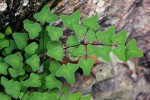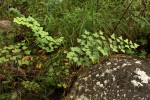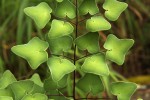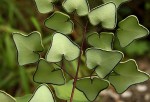Pellaea calomelanos (Sw.) Link var. swynnertoniana (Sim) Schelpe
Synonyms |
Pellaea swynnertoniana Sim |
|---|---|
Common name |
Blue rock fern Mumvuriwedombo |
Description |
Rhizome erect to shortly creeping, c. 6 mm in diameter; rhizome scales linear-lanceolate in outline, apex slowly tapering to a point, margins pale, up to 10 mm long, black. Fronds monomorphic, tufted, erect to arching, usually more than 40 cm tall, coriaceous. Stipe 5-30 cm long, round, black, very shining, hairless or finely set with orange-brown short hairs on the upper surface, sometimes with a few scales similar to the rhizome scales near the base, old stipe bases present. Lamina mostly 2-pinnate, occasionally 3-pinnate on the lower pinnae, ovate -lanceolate to narrowly triangular in outline, 10-43 × 2.5-25 cm; pinnae 7-12 pairs, opposite to slightly alternate, oblong-ovate in outline, 1.5-6 cm long; pinnules more than 2 cm long, rounded to broadly hastate, with 3-5 acute to rounded points, articulated, petiolate, grey to bluish green above, paler below, hairless; venetion free, hardly visible; rhachis and secondary rhachis shiny black, hairless or finely set with orange-brown short hairs on the upper surface. Sori borne in a continuous ridge along the margins, indusium continuous, entire, membranous. |
Notes | The rounded to broadly hastate pinnules, with typically 3-5 acute to rounded points, a grey-green colour and thick texture make this species easy to recognize. Could be confused with P. calomelanos var. calomelanos which has smaller fronds, pinnules that are less than 2 cm long and is more common. |
Derivation | kalos: pretty, melanos: dark; alluding to the glossy black stipe and rhachis of the plant. swynnertoniana: named after C.F.M. Swynnerton (1877-1938), well known collector & forester at Mt. Selinda. |
Habitat | High altitude Brachystegia spiciformis woodland on granite or quartzite outcrops, in Uapaca kirkii woodland on heavier soils, in areas with frequent mist and high rainfall. |
Distribution worldwide | |
Distribution in Africa |
|
Growth form |
Lithophytic, terrestrial. |
Literature |
|



